
Vietnam, a Southeast Asian gem, offers a captivating blend of natural wonders, historical sites, and vibrant culture. From bustling cities to serene landscapes, there's something for everyone. Here are some of the best places to visit in Vietnam, along with exciting activities to experience:
Top 5 best places to visit in Vietnam - Central areas
Ha Long Bay
Ha Long Bay, located in the northeastern part of Vietnam, is a UNESCO World Heritage site and one of the country’s most iconic natural attractions. Here’s what makes Ha Long Bay special and the best things to experience:

Stunning Scenery
- Karst Limestone Islands: The bay is dotted with nearly 2,000 islands and islets, formed by stunning limestone karsts that rise dramatically from the sea. Each island has its unique shape, with some resembling animals or objects, creating a surreal landscape.
- Emerald Waters: The calm, green waters of Ha Long Bay are perfect for boating and kayaking, offering breathtaking views as you explore its hidden gems.
Must-Visit Islands and Caves
- Ti Top Island: Famous for its crescent-shaped beach and a viewpoint that offers panoramic views of the bay. A short hike to the top rewards visitors with one of the best vistas in Ha Long.
- Sung Sot Cave (Surprise Cave): The largest and most famous cave in Ha Long Bay, known for its grand chambers filled with stalactites and stalagmites. Its vast, cathedral-like interior feels otherworldly.
- Dau Go Cave (Wooden Stakes Cave): One of the oldest caves in the area, featuring impressive rock formations and historical significance as the site where wooden stakes were stored during battles against invaders.
- Luon Cave: Best explored by kayak, this cave leads to a peaceful lagoon surrounded by towering cliffs. It’s a perfect spot for those seeking serenity and natural beauty.
Outdoor Activities
- Cruise the Bay: The best way to experience Ha Long Bay is by boat. There are options for day cruises, overnight cruises, or luxury junk boats that allow you to explore the islands, caves, and hidden beaches. A sunset cruise is a particularly magical way to end the day.
- Kayaking: Paddle through the calm waters and explore secluded lagoons, hidden caves, and pristine beaches. Kayaking gives you a closer connection to the natural beauty of the bay.
- Swimming and Snorkeling: Take a dip in the refreshing waters or snorkel around the islands to discover the colorful marine life beneath the surface.
- Hiking: For those seeking adventure, several islands like Cat Ba offer hiking trails. Climb to the top of hills and mountains for stunning panoramic views of the bay.
Relaxing Beach Escapes
- Bai Chay Beach: A popular beach with soft sand and calm waters, Bai Chay is perfect for swimming, sunbathing, and water sports. Nearby restaurants offer fresh seafood with a beautiful view of the bay.
- Soi Sim Island: A quieter, more secluded beach where you can relax in tranquility and enjoy the natural beauty away from the crowds.
Hanoi, the capital city of Vietnam, is a dynamic mix of ancient history and modern vibrancy. This thousand-year-old city offers a captivating blend of traditional charm and contemporary life, making it a top destination for travelers. Here’s what makes Hanoi special and some of the best things to experience in the city:
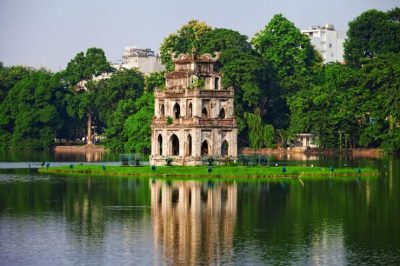
Historical Landmarks
- Old Quarter: The beating heart of Hanoi, famous for its narrow streets and ancient architecture. The 36 streets, each named after a different trade, are perfect for exploring on foot.
- Ho Chi Minh Mausoleum: A tribute to Vietnam’s revered leader, this grand monument is where the body of Ho Chi Minh rests. The nearby Presidential Palace and Ho Chi Minh’s stilt house are also worth visiting.
- Temple of Literature: Vietnam’s first university, founded in 1070, offers a peaceful retreat with its beautiful courtyards, ponds, and pavilions dedicated to Confucianism.
- Hoa Lo Prison: Known as the "Hanoi Hilton," this historic prison offers a glimpse into Vietnam’s colonial and revolutionary past.
Cultural Highlights
- Water Puppet Show: A traditional Vietnamese art form performed on water, typically accompanied by live folk music. It’s a must-see at the Thang Long Water Puppet Theatre.
- Hoan Kiem Lake & Ngoc Son Temple: Located in the center of the city, this serene lake is perfect for a morning stroll or an evening walk. The iconic red Huc Bridge leads to Ngoc Son Temple, where you can enjoy scenic views of the water.
- West Lake (Ho Tay): A massive lake surrounded by upscale restaurants, cafes, and pagodas. The Tran Quoc Pagoda, the city’s oldest, is located on a small island in the lake.
Vibrant Street Life
- Street Food: Hanoi’s street food culture is world-famous. Don’t miss trying dishes like Pho (Vietnamese noodle soup), Bun Cha (grilled pork with noodles), and Banh Mi (Vietnamese sandwich).
- Night Markets: The weekend night market in the Old Quarter is a lively spot to shop for souvenirs, and street food, and experience Hanoi’s nightlife.
- Ta Hien Street: Also known as “Beer Street,” this is where locals and tourists gather to enjoy cheap beer and street food in a vibrant, friendly atmosphere.
Hoi An
Hoi An, located in central Vietnam, is a UNESCO World Heritage site that offers visitors a magical blend of ancient charm, stunning architecture, and vibrant culture. Here’s why Hoi An is one of the best places to visit in Vietnam and the top things to do:
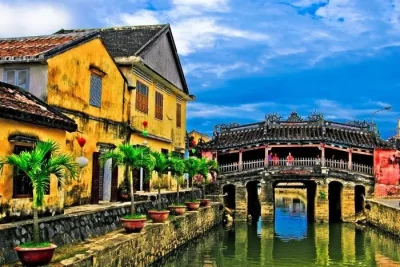
Historical Architecture
- Hoi An Ancient Town: The heart of Hoi An is its ancient town, where narrow streets are lined with beautifully preserved buildings showcasing a mix of Vietnamese, Chinese, Japanese, and European architectural styles.
- Japanese Covered Bridge: Built in the 16th century, this iconic bridge is a symbol of Hoi An. Its arched wooden structure and ornate details make it a must-see.
- Tan Ky House: A historic merchant’s house that has been preserved for seven generations. Visitors can explore the house’s unique mix of Chinese, Japanese, and Vietnamese architectural styles and see how merchants once lived and conducted business.
Cultural Experiences
- Lantern Festival: Held on the 14th day of each lunar month, Hoi An’s Lantern Festival transforms the town into a sea of glowing lanterns. Visitors can release their lanterns onto the Thu Bon River for good luck, making this one of the most magical experiences in Vietnam.
- Chinese Assembly Halls: There are several ornate assembly halls in Hoi An, including the Cantonese and Fujian Halls, which were built by Chinese merchants.
Shopping and Tailoring
- Custom Tailoring: Hoi An is famous for its tailors, who can create custom-made clothing within a day or two. Whether you're looking for suits, dresses, or traditional Vietnamese outfits, Hoi An’s tailors are known for their quality and craftsmanship.
- Artisan Shops: Stroll through the ancient town’s streets, where you’ll find countless artisan shops selling hand-crafted lanterns, ceramics, paintings, and other souvenirs. The town’s vibrant markets, such as Hoi An Central Market, are also great for local food, spices, and handicrafts.
Outdoor Activities
- Thu Bon River Cruises: Take a boat ride along the peaceful Thu Bon River to experience Hoi An from a different perspective. You can also book sunset or lantern-lit evening cruises for a more romantic experience.
- An Bang Beach: Just a short ride from Hoi An’s old town, An Bang Beach offers a relaxing escape with soft sand and clear waters. There are plenty of beachside restaurants where you can enjoy fresh seafood.
- Cycling: Explore Hoi An’s scenic countryside by bike, where you’ll pass through rice paddies, quaint villages, and local farms. Cycling tours often include stops at handicraft villages and organic vegetable farms like Tra Que.
Hue
Hue, located in central Vietnam along the banks of the Perfume River, is a city rich in history and culture. Once the capital of the Nguyen Dynasty from 1802 to 1945, Hue is renowned for its well-preserved historical sites, ancient temples, and royal architecture. Here’s what makes Hue special and the top things to experience:
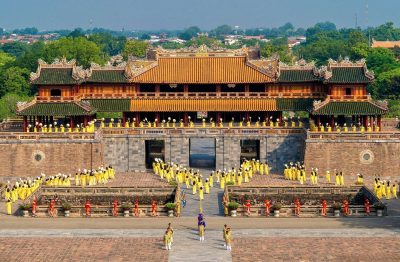
Imperial History
- Imperial City (Citadel): The heart of Hue’s historical significance, this massive citadel is a UNESCO World Heritage site. It encompasses the Forbidden Purple City, the former imperial palace, and numerous temples and halls. Visitors can explore the grand entrance gates, royal courtyards, and ancient residences that once housed Vietnam’s emperors.
- Royal Tombs: Several impressive tombs of Nguyen emperors are scattered around Hue, each with unique architectural styles and scenic settings:
- Tomb of Khai Dinh: Known for its eclectic blend of Eastern and Western architectural elements, this tomb features intricate mosaics and grand statues.
- Tomb of Minh Mang: Set amidst a serene landscape, this tomb showcases traditional Vietnamese architecture with its symmetrical layout and beautiful gardens.
- Tomb of Tu Duc: This tomb is known for its tranquil setting and elaborate complex of pavilions, ponds, and statues.
Cultural and Religious Sites
- Thien Mu Pagoda: One of Hue’s most iconic landmarks, this seven-story pagoda stands on a hill overlooking the Perfume River. It’s a major religious site and offers stunning views of the surrounding area.
- Tu Hieu Pagoda: A peaceful temple known for its beautiful gardens and traditional architecture. It’s a great place to experience the tranquil side of Hue’s spiritual life.
Architectural Marvels
- Dong Ba Market: A bustling market that offers a vibrant glimpse into local life. You can find traditional Vietnamese foods, handicrafts, and souvenirs. It’s a great place to sample local specialties and experience the everyday hustle and bustle.
- Hue Museum of Royal Fine Arts: Located within the Imperial City, this museum showcases a rich collection of artifacts from the Nguyen Dynasty, including royal costumes, ceramics, and paintings.
Tam Coc
Tam Coc, located in the Ninh Binh province of northern Vietnam, is often referred to as the “Halong Bay on Land” due to its stunning limestone karsts that rise dramatically from lush rice paddies and serene rivers. This natural wonder offers visitors a peaceful escape from the hustle and bustle of urban life, with breathtaking landscapes, caves, and historical sites to explore. Here’s what makes Tam Coc special and the top things to do:
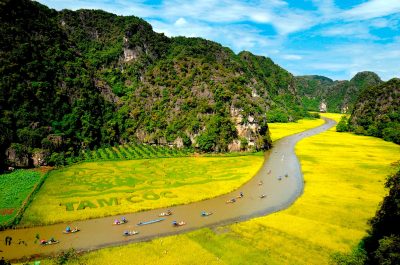
Boat Tours
- Tam Coc Boat Ride: The highlight of any trip to Tam Coc is the boat ride along the Ngo Dong River. Traditional rowboats, typically rowed by local women using their feet, take visitors on a 2-hour journey through the landscape. You’ll pass through three natural caves—Hang Ca, Hang Hai, and Hang Ba—which were carved into the limestone by the river.
- Trang An Boat Tour: Just a short distance from Tam Coc, the Trang An Scenic Landscape Complex offers another breathtaking boat ride. This UNESCO World Heritage site is known for its peaceful rivers, caves, and temples nestled among the karsts.
Caves and Temples
- Bich Dong Pagoda: Located just outside of Tam Coc, this ancient pagoda is built into a limestone mountain. The pagoda consists of three levels—Ha Pagoda, Trung Pagoda, and Thuong Pagoda—each offering beautiful views of the surrounding countryside. A short climb leads to the highest level, where you can enjoy panoramic views of the karsts and rice fields.
- Thien Ha Cave: Known as the "Galaxy Cave," this lesser-known cave is located near Tam Coc and features stunning stalactites and stalagmites. A boat ride through the cave reveals its natural beauty and serene atmosphere.
Historical and Cultural Sites
- Hoa Lu Ancient Capital: Located near Tam Coc, Hoa Lu was the capital of Vietnam in the 10th and 11th centuries. Visitors can explore the temples dedicated to Emperor Dinh Tien Hoang and Emperor Le Dai Hanh, as well as the remaining vestiges of the ancient capital.
- Phat Diem Cathedral: An architectural marvel, this cathedral is a blend of Vietnamese and European design. Located in the nearby town of Phat Diem, it’s one of the most unique churches in Vietnam, featuring stone carvings and pagoda-style roofs.
Where to visit in South Vietnam
Mekong Delta
The Mekong Delta, a lush and vibrant region in southern Vietnam, is known for its intricate waterways, floating markets, and rich agriculture. It offers an authentic glimpse into rural life and is perfect for travelers looking to explore Vietnam's natural beauty and culture.
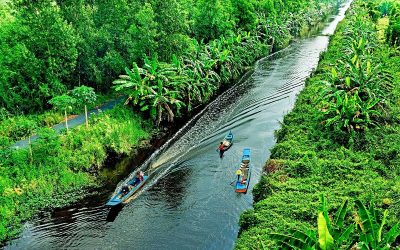
Top Attractions
- Cai Rang Floating Market: The largest and most popular floating market in the delta, offering fresh produce and local goods traded on boats.
- Mekong River Cruises: Peaceful boat rides through narrow canals surrounded by coconut groves, rice paddies, and local villages.
- Ben Tre: Known for its coconut groves, take a boat tour to see local workshops, traditional brick kilns, and quiet rural life.
Nature & Wildlife
- Tra Su Cajuput Forest: A birdwatcher’s paradise with serene boat rides through flooded forests.
- Fruit Orchards: Taste fresh, tropical fruits like durian, rambutan, and dragon fruit directly from the source.
Cultural Highlights
- Home Stays: Stay with local families for a truly immersive experience in the delta’s way of life.
- Cao Dai Temple: Visit this colorful, religious site to learn about Vietnam’s unique Cao Dai faith.
The Mekong Delta is a perfect mix of nature, culture, and cuisine, offering an unforgettable Vietnamese experience.
Cu Chi Tunnels
The Cu Chi Tunnels, located just outside Ho Chi Minh City, are an extensive underground network used by the Viet Cong during the Vietnam War. Stretching over 250 kilometers, these tunnels served as living quarters, supply routes, and hiding spots, playing a crucial role in the war effort. Today, they are a popular historical site where visitors can explore and learn about Vietnam’s resistance.
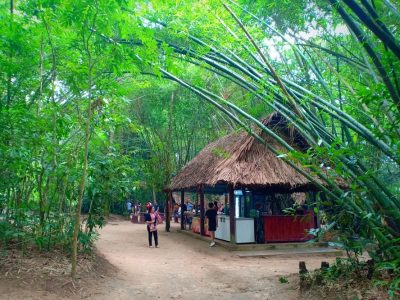
Top Things to Do
- Explore the Tunnels: Visitors can crawl through sections of the narrow tunnels to experience what life was like underground for the Viet Cong soldiers.
- War Exhibits: The site features displays of traps, weapons, and bunkers used during the war, providing insight into guerrilla warfare tactics.
- Firing Range: For those interested, there's an opportunity to try firing Vietnam War-era firearms at a shooting range on-site.
The Cu Chi Tunnels offer a powerful, immersive experience into Vietnam’s wartime history, making it one of the best places to visit in Vietnam for history buffs and travelers looking to understand the country's past.
Ho Chi Minh
Ho Chi Minh City, formerly known as Saigon, is Vietnam’s largest and most dynamic city. A bustling metropolis blending old-world charm with modern energy, it offers visitors a mix of historical landmarks, vibrant markets, and a thriving food scene. The city is a hub for culture, commerce, and entertainment in Vietnam.
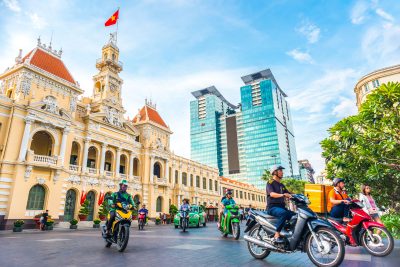
Top Attractions
- Ben Thanh Market: A lively market where you can shop for local goods, souvenirs, and street food.
- War Remnants Museum: A sobering museum showcasing the impacts of the Vietnam War, with powerful exhibits on the war’s legacy.
- Notre Dame Cathedral & Central Post Office: These iconic French colonial buildings are must-sees for their stunning architecture.
Things to Do
- Cu Chi Tunnels: A short trip from the city, explore the famous underground tunnel system used during the Vietnam War.
- Saigon Skydeck: Take in panoramic views of the city from the 49th floor of the Bitexco Financial Tower.
- Bui Vien Street: Known for its nightlife, this vibrant street offers a mix of bars, restaurants, and entertainment.
Ho Chi Minh City is the perfect blend of history, culture, and modernity, making it a top destination for travelers seeking both excitement and tradition.
Nha Trang - One of the best places to visit in Vietnam
Nha Trang offers a perfect blend of relaxation and adventure. Whether you're seeking sun-soaked beaches, exciting water sports, or cultural experiences, Nha Trang has something to offer everyone.
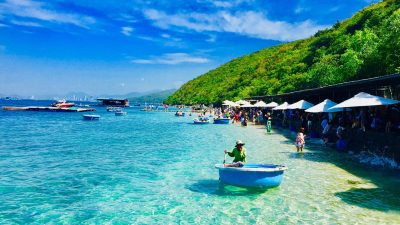
Top Attractions in Nha Trang:
- Beaches: Nha Trang is famous for its pristine beaches, such as Nha Trang Beach and Hon Chong Beach. Enjoy swimming, sunbathing, and water sports.
- Diving and Snorkeling: Explore the underwater world and discover colorful coral reefs and marine life.
- Islands: Take a boat trip to nearby islands like Hon Tre and Hon Mun for stunning views and secluded beaches.
- Vinpearl Land: This amusement park offers thrilling rides, water parks, and a cable car that offers breathtaking views of the city and bay.
- Po Nagar Cham Towers: These ancient Cham towers offer a glimpse into the region's rich history and culture.
Beach Activities
- Relax and sunbathe: Enjoy the pristine beaches and soak up the sun.
- Swim in the crystal-clear waters: Take a refreshing dip in the ocean.
- Go snorkeling or diving: Explore the vibrant underwater world.
- Try water sports: Enjoy activities like parasailing, jet skiing, or windsurfing
Tips while traveling to Vietnam - FAQ
Vietnam is a diverse country with stunning landscapes, rich history, and vibrant culture. Here are some essential tips to help you make the most of your trip:
When to Go To Vietnam?
Vietnam’s climate varies by region, so the best time to visit depends on where you're headed:
- North Vietnam (Hanoi, Halong Bay, Sapa): The best time to visit is October to April when the weather is cool and dry. Summers (May to September) can be hot and rainy.
- Central Vietnam (Hue, Da Nang, Hoi An): Visit between February and August for warm weather and fewer chances of rain. From September to November, the region may experience storms and heavy rains.
- South Vietnam (Ho Chi Minh City, Mekong Delta): The dry season from December to April is ideal for travel, with warm temperatures and little rain. The rainy season (May to November) is still a good time to visit, as the rains are usually short and intense.
The Cost of Traveling in Vietnam for a Month
Vietnam is an affordable destination, especially for budget travelers. Here's a rough estimate of costs for a month-long trip:
- Accommodation:
- Hostels: $5–$15 per night.
- Mid-range hotels: $20–$50 per night.
- Luxury hotels: $70 and up per night.
- Food:
- Street food: $1–$3 per meal (Pho, Banh Mi).
- Local restaurants: $3–$10 per meal.
- Fine dining: $15 and up per meal.
- Transport:
- Domestic flights: $30–$100 per flight.
- Buses and trains: $5–$20 for long distances.
- Motorbike rental: $5–$10 per day.
- Activities: Many attractions are free or low-cost (under $10), while tours (Halong Bay, Sapa trekking) can range from $20–$150.
Average budget for one month:
- Backpacker: $500–$1,000.
- Mid-range: $1,200–$2,000.
- Luxury: $3,000 and up.
Vietnam Visas
Most travelers to Vietnam require a visa, but there are various options depending on your nationality:

- Visa on Arrival (VOA): Available for those flying into major airports like Hanoi, Da Nang, or Ho Chi Minh City. You'll need to apply for an approval letter online before arriving and pick up the visa at the airport.
- E-Visa: Citizens from over 80 countries can apply for a 30-day single-entry e-visa online, which is valid at certain airports, land crossings, and seaports.
- Visa Exemptions: Some nationalities (e.g., ASEAN countries, South Korea, Japan) can visit Vietnam for short stays (15-30 days) without a visa.
For longer stays or multiple entries, you may need to apply for a visa through the Vietnamese embassy or consulate.
Vietnam Transit Options
Getting around Vietnam is convenient and varied, with options to suit different budgets and preferences:
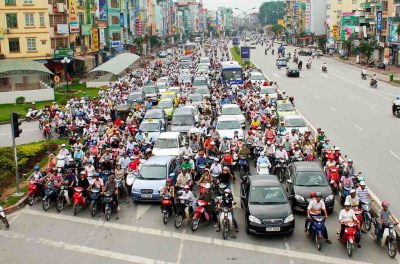
- Domestic Flights: The fastest way to travel between major cities (e.g., Hanoi to Ho Chi Minh City). Carriers like Vietnam Airlines, Bamboo Airways, and VietJet Air offer regular, affordable flights.
- Trains: Vietnam’s Reunification Express runs from north to south, offering scenic views. Trains are comfortable but slower than buses or flights.
- Buses: Sleeper buses are popular for long distances (e.g., Hanoi to Hue). Buses are cheap and frequent, but journeys can be long and bumpy.
- Motorbikes: A common and fun way to explore Vietnam, especially in cities and rural areas. You can rent motorbikes cheaply, but remember that traffic can be chaotic.
- Taxis & Ride-Hailing: Taxis are abundant in cities, and apps like Grab make getting around convenient and affordable.
- Cyclo: A traditional Vietnamese bicycle rickshaw, ideal for short rides in city centers like Hanoi or Hoi An.











